
By Josh Moran
You?ve probably seen various ?family trees? in museums that try to illustrate the evolution of human beings. They start out with an ape-like creature with a scientific-sounding name at the bottom and then branch outwards and upwards, culminating with something like Ozzie and Harriet perched at the top.
Imagine that same kind of tree but one that shows the evolution of the manner in which we have cooled and heated our living spaces since the dawn of human history. It would start out with various ancient passive systems, evolve into controlled fires, work its way up to simple fans, branch out to evaporative coolers and finally make its way to modern HVAC systems.
However, unlike the family trees where the branches of human ancestors come to an abrupt end, in the heating and cooling tree, ancient passive systems don?t entirely disappear. Many are still in use, and some are even being exploited to complement high-tech HVAC systems.
Six feet under for a good reason
Perhaps you?ve heard this riddle: A Thermos bottle is designed to keep cold things cold and hot things hot. How does it know the difference?
This simple conundrum points to one of the classic passive heating and cooling systems we use on our planet. Structures whose space is partially created by digging a hole in the ground have been used in a number of different cultures around the world for thousands of years. People groups such as the Japanese during the Final Jomon Period (2500-300 BCE), the Vikings and the Native Americas at Mesa Verde have all used variations of the pit house.
PHOTO: Step House ruins: Mesa Verde National Park
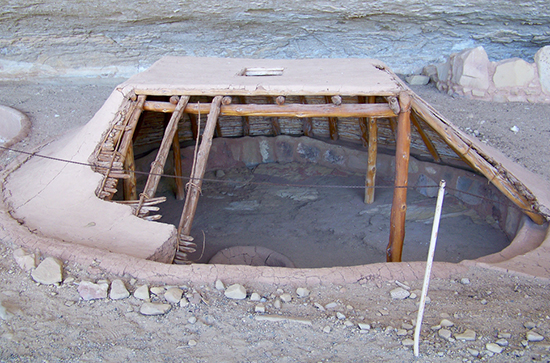
Just like a Thermos, when a person is living in a hole in the ground, the earthen walls provide natural air conditioning in the summer and warmth in the winter. This is due to the fact that once you get below the top layer of dirt, the temperature of the soil stays very constant throughout the year. Root cellars and wine cellars also take advantage of this convenient fact.
The spelunking lifestyle
The hole in the ground doesn?t have to go downward either. Burrowing into the side of a mountain will deliver the same results. When nature does this on its own, we call it a cave, and that takes us back to the first human use of passive heating and cooling.
The climate inside a cave remains so stable that even through centuries of heating and cooling, fine works of art, such as the famous Lascaux cave paintings in France, are wonderfully preserved. Those paintings date back some 30,000 years and are in far better condition than many of the paintings in the Louvre.
PHOTO: The troglodytes (cave dwellers) in Graufthal, France have taken the ?cave man? lifestyle to a much higher level.
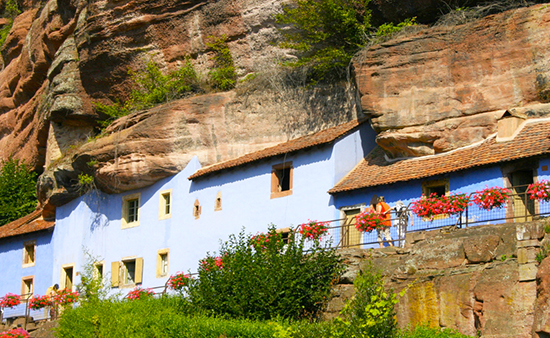
When your home is kept warm in the winter and cool in the summer simply by a hole in the ground, it doesn?t require the expense of any energy, especially if you don?t count the effort it took to dig the hole. This energy-saving approach is finding new life today.
Drilling for dollars
Today we?re seeing this principle exploited in a new way: geothermal heat pumps. A hole is drilled into the earth and filled with piping. A new HVAC unit pumps water or antifreeze through this buried pipe. In the winter this flowing liquid moves heat from the ground to the building. In the summer, heat collected from inside the building is transferred into the soil through the liquid as it flows through the buried pipe.
PHOTO: The Community Emergency Services Station in Fort Bragg, North Carolina, uses geothermal heat pumps.
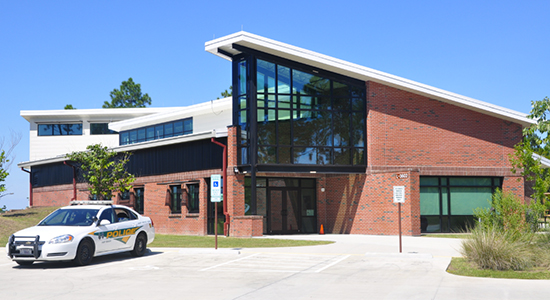
Ordinary systems accomplish the same thing by transferring heat to and from the air; however, the wild variations in air temperature decrease efficiency. Being able to rely on the constant temperature of the soil allow geothermal heat pumps to be remarkably energy efficient. Along with heating homes, geothermal heat pumps are often used to heat water.
Do just the opposite
In some climates, doing the exact opposite of burying the building has proven to be the most effective way to achieve passive cooling, and like digging into the ground, this passive system has been in use for thousands of years. In tropical climates, notably throughout large parts of India, buildings are being raised to allow air to pass beneath their bottom floors.
When raised, a shady patio area is created that is used for an array of activities. New government buildings in India are incorporating this passive design along with other features we?ll discuss in a moment, and the open area that is created is used for recreation or as exhibit space.
PHOTO: House on stilts
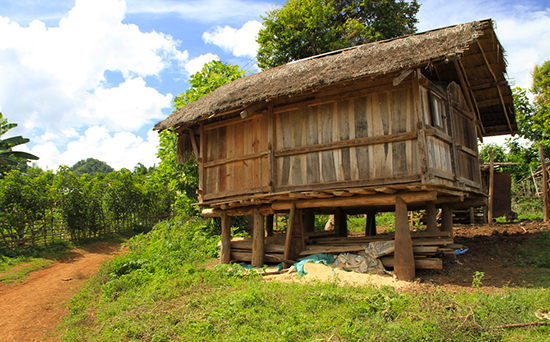
Raising a house on stilts has been used a strategy to help cool homes in the tropics in addition to protecting them from rising water. Modern commercial buildings are beginning to cash in on the energy savings that this architectural strategy delivers.
Going even further
Anyone who has visited a theme park during the dog days of summer will have probably encountered some kind of ?cooling station.? It?s usually an area jam-packed with misters. Step into one for a moment to experience the power of evaporative cooling. An even better example would be what we lovingly call ?swamp coolers.? When water evaporates, it lowers the air temperature. This is another way the ancients exploited passive cooling.
Mughal palaces, dating back 1,500 years, were built over a ?step pool? of water. As the water evaporates, it cools the structure above. The Pearl Academy of Fashion in Jaipur, India uses a step pool as well as a raised first floor and other passive cooling techniques. These can cause the building to be as much as 20 degrees cooler than the outside ambient temperature.
PHOTO: A step pool
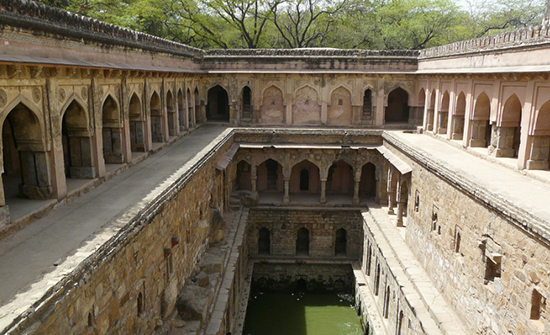
Another simple traditional strategy used at the fashion academy is the addition of a latticed screen called ?jaali? that shades the outside walls of the building. These are often seen in Muslim architecture and at first seem to be merely decorative. However, looking beyond the beauty, the structures allows shade and air movement to surround the buildings. Today, awnings perform the same function on many modern buildings.
PHOTO: Jaali

Flow-Through Ventilation
Evident in many buildings where the goal is to find ways to beat the summer heat is the principle of flow through ventilation. Browse through a big box home improvement store as summer starts to set in and you?ll find window fan units that can be set to either exhaust hot air from the home or pull in cool air from outside. When units are set in widows at opposite ends of the house, one to exhaust and the other to pull in fresh air, they can be tremendously effective at cooling the home in the evening, nighttime and early morning hours.
Traditional Persian architecture and other Middle Eastern cultures often design passive cooling systems into buildings with a ?windcatcher.? In its most simple configuration, it is a tall tower with the top of one side open and facing the direction of the prevailing wind. It ?catches? the wind and directs it through the building?free air conditioning.
PHOTO: Windcatcher
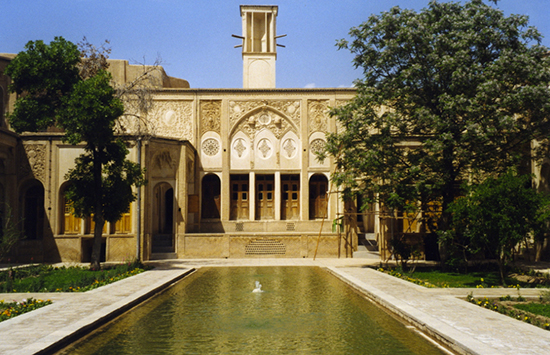
Also found in middle eastern architecture is the darkly-painted solar chimney. Sunlight heats the thermal mass to a blistering degree causing the air inside to heat and create a natural upflow. The air drawn in from below creates a natural breeze which, combined with the cooler air, makes a very pleasant environment.
PHOTO: Diagram of a solar chimney cooling system.
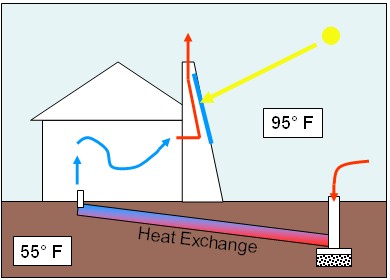
Here is the modern equivalent in a Zion National Park visitor?s center; A close relative to the solar chimney is a cool tower, which works even better when paired with a solar chimney on the opposite side of the building.
PHOTO: Diagram of a cooling tower.

It?s plain to see that many of these systems are still being used today; however, with the ease of throwing a switch or setting a thermostat, we probably aren?t taking advantage of them as much as we should. Integration into house plan books available to the modern family would increase awareness and awakening of these energy-saving designs. With a little advanced planning, more of us could probably use our HVAC systems less often, reducing our utility bills and extending the lives of our equipment.
Josh Moran works with Tom?s Mechanical, a heating and cooling company in the great state of Texas, where the summer heat means that even the thermometers are bigger. See their Google Plus profile.
Sources:
http://www.planetseed.com/relatedarticle/energy-efficient-building-passive-heating-and-cooling
http://www.consumerenergycenter.org/home/heating_cooling/geothermal.html
http://www.cnn.com/2012/02/28/world/asia/ancient-air-conditioning-architecture
http://en.wikipedia.org/wiki/Windcatcher
Environmental News from Living Green Magazine ? Where Green Is Read
?
?
Category: Featured Articles, Home & Garden
Stephanie Bongiovi stanford football guy fieri Jill Kelley hope solo hope solo tesla model s
No comments:
Post a Comment
Note: Only a member of this blog may post a comment.